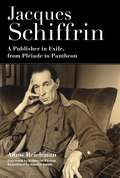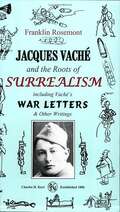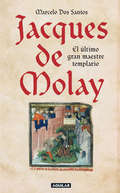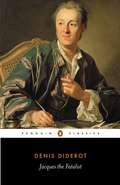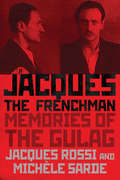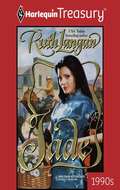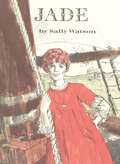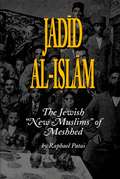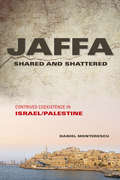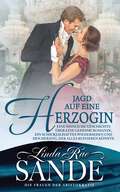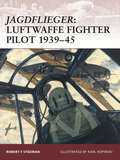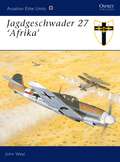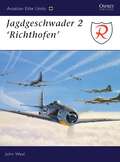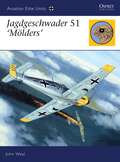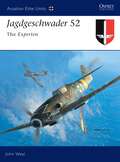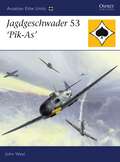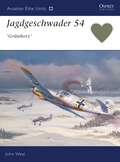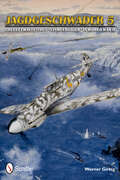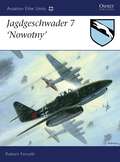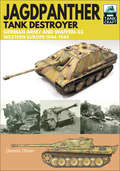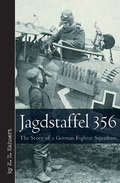- Table View
- List View
Jacques Schiffrin: A Publisher in Exile, from Pléiade to Pantheon
by Amos ReichmanJacques Schiffrin changed the face of publishing in the twentieth century. As the founder of Les Éditions de la Pléiade in Paris and cofounder of Pantheon Books in New York, he helped define a lasting canon of Western literature while also promoting new authors who shaped transatlantic intellectual life. In this first biography of Schiffrin, Amos Reichman tells the poignant story of a remarkable publisher and his dramatic travails across two continents.Just as he influenced the literary trajectory of the twentieth century, Schiffrin’s life was affected by its tumultuous events. Born in Baku in 1892, he fled after the Bolsheviks came to power, eventually settling in Paris, where he founded the Pléiade, which published elegant and affordable editions of literary classics as well as leading contemporary writers. After Vichy France passed anti-Jewish laws, Schiffrin fled to New York, later establishing Pantheon Books with Kurt Wolff, a German exile. Following Schiffrin’s death in 1950, his son André continued in his father’s footsteps, preserving and continuing a remarkable intellectual and cultural legacy at Pantheon. In addition to recounting Schiffrin’s life and times, Reichman describes his complex friendships with prominent figures including André Gide, Jean-Paul Sartre, Peggy Guggenheim, and Bernard Berenson. From the vantage point of Schiffrin’s extraordinary career, Reichman sheds new light on French and American literary culture, European exiles in the United States, and the transatlantic ties that transformed the world of publishing.
Jacques Vache and the Roots of Surrealism: Including Vache's War Letters & Other Writings
by Franklin RosemontLiterary Nonfiction. Fiction. Biography. Conscripted into the French Army in World War One, Jacques Vache soon became not only the unsurpassed champion of "Desertion from Within," but also the master of "Disservice with Diligence." His post-humous slim book, War Letters (1919)--included in the present volume--is a classic of surrealist anti-militarism and subversion. Renowned as the Inventor of Umour (Humour without the H), Vache was--along with Isidore Ducasse, Comte de Lautreamont--the major inspirer of Andre Breton and the surrealist revolution. The first of its kind in English, this book chronicles Vache's boundless originality, creative nonconformity, revolutionary morality (or umoral-ity), and his all-out turn-the-world-upside-down hilarity. Welcomed by Andre Breton himself into the Paris Surrealist Group in 1966, Franklin Rosemont took part in the Paris group's activities for several months and went on to co-organize the Chicago Surrealist Group later that year. Rosemont (1943-2009) died earlier this year.
Jacques de Molay: El último gran maestre templario
by Marcelo Dos SantosConozca en este nuevo libro de Marcelo Dos Santos, autor de El manuscrito Voynich, la odisea de Jacques de Molay, último gran maestre de la Orden de los Templarios. A principios del siglo XIV la sociedad europea veía el imparable avance de las órdenes monásticomilitares. Los principales de entre estos miles de monjes guerreros eran los Caballeros Templarios (orden fundada en la Jerusalén recién conquistada en la cruzada) quienes fundaron verdaderos imperios espirituales y económicos en las sociedades europeas de su época. De estricta observancia religiosa, obediencia ciega a los reyes y al papado, valor a toda prueba y un enorme espíritu de sacrificio, los Templarios estaban obligados a aceptar el combate de uno contra tres, no podían comprar sus vidas con rescates si caían prisioneros y se les exigía cumplir con otras severísimas reglas. Además de ello, debían someterse a los tres votos tradicionales de los religiosos cristianos: obediencia, pobreza y castidad. Encontraron tiempo aún para dedicarse a la producción agrícola, a la construcción de muchas de las grandes catedrales europeas y a financiar grandes proyectos y emprendimientos. A pesar de todas sus virtudes, sin embargo, un buen día cayeron en desgracia y fueron aniquilados.
Jacques the Fatalist and His Master
by Denis Diderot Martin Hall Michael HenryThe world of Jacques is not a fixed and settled one where events are easily assessed and interpreted; on the contrary, it is a world of dizzying variety and unpredictability. For nothing is quite as it seems and an alarming proliferation of anecdotes, characters and philosophical problems continues to spring up around the apparently central theme of the relationship between Jacques and his master, in a skilled and devastating assault on the supremacy of the stylized novel. Book jacket.
Jacques, the Frenchman: Memories of the Gulag
by Jacques Rossi Michele SardeJacques Rossi is one of Stalin’s most well-known victims. Author of The Gulag Handbook, a fascinating encyclopedia of the Soviet forced labor camps, Rossi spent twenty years in interrogation, prison, and Gulag detention. Born to a prominent Polish father and French mother, the young Jacques became attracted to communism as a blueprint for radical social reform. He spent years in the communist underground in interwar Europe, agitating for the revolution, but he was arrested during Stalin’s Great Purges in 1937. This book represents a conversation between Jacques Rossi and Michèle Sarde, professor emerita at Georgetown University, and weaves together personal reflections and historical analysis. Rossi’s remarkable life (1909–2004) spanned the twentieth century and sheds important light on the tumultuous history of Europe – the appeal of communism in the interwar period and beyond, the mentality of party members, the effects of mass repression, everyday life in Stalin’s Gulag, and the problem of rights for former prisoners during the Khrushchev era. As he abandoned his internationalist communist beliefs, Rossi increasingly identified as French, embracing the name his fellow prisoners gave him in the Gulag, "Jacques the Frenchman." Rossi’s reflections on his own political beliefs, his frustrations with those who could not accept the truth of his brutal experiences in the Soviet Union, and his life as a witness to one of the twentieth century’s worst crimes offer a fascinating history of Stalinism and its legacies.
Jade
by Ruth LanganThe Town Preacher And The Town Madam...Haunted by his sordid past as the notorious gunslinger Nevada, Reverend Wade Weston had declared war against sin in the small town of Hanging Tree, Texas. But he hadn't counted on the arrival of the exotic Jade Jewel, whose visions of building a pleasure palace threatened the peace of the community, and whose person aroused in him passions that threatened to claim his immortal soul.Diamond, Pearl, Jade and Ruby, The Jewels of Texas. Four sisters as wild and vibrant as the untamed land they fought to protect.
Jade (Sally Watson Family Tree #6)
by Sally WatsonHer name was Melanie Lennox, but she preferred to be called Jade. "Swords, adventure, freedom," sixteen year old Melanie cried," and I'll pay any price!" Driven by her courageous, independent spirit and hatred of slavery, Jade attempts to release a ship's cargo of slaves destined for bondage in Virginia. While she is being publicly flogged for her efforts, the ship is captured by pirates, and Jade, undaunted and realizing her opportunity for adventure, decides to join them.
Jade Star
by Catherine CoulterVowing to save a young girl from her painful past, Saint Morris marries her out of duty. He thinks of himself as her protector and brother. But she has other ideas....
Jadid al-Islam: The Jewish “New Muslims” of Meshhed (Raphael Patai Series in Jewish Folklore and Anthropology)
by Raphael PataiIn 1839, Muslims attacked the Jews of Meshhed, murdering 36 of them, and forcing the conversion of the rest. While some managed to escape across the Afghan border, and some turned into true believing Muslims, the majority adopted Islam only outwardly, while secretly adhering to their Jewish faith. Jadid al-Islam is the fascinating story of how this community managed to survive, at the risk of their lives, as crypto-Jews in an inimical Shi'i Muslim environment. Based on unpublished original Persian sources and interviews with members of the existing Meshhed community in Jerusalem and New York, this study documents the history, traditions, tales, customs, and institutions of the Jadid al-Islam--"New Muslims."
Jadwiga, Poland’s Great Queen
by Charlotte Kellogg Frank H. SimondsHERE is the story of a great love and a great sacrifice and of a queen’s work built on that sacrifice. It takes us back five hundred years, to the brilliant court of that King Louis of Hungary who ruled the half of Europe—the court where his gifted youngest daughter, Jadwiga, grew up. It takes us to Vienna, for Jadwiga was betrothed to the young Crown Prince of Austria. Then to Krakow, early capital of Poland, where Jadwiga was called as queen and where she made her supreme renunciation.Through it and her marriage with the Lithuanian Grand Duke, Jagiello, she brought the last pagan people of Europe into the fold of the Western Church, and raised a barrier against the eastern push of the German soldiers of the Cross, which made possible a Poland stretching from the Baltic to the Black Sea. Thenceforth the union of Poland and Lithuania was known as the “Wedding ring of Jadwiga.”Through darkest days she kept her faith, until she was reverenced throughout Europe for her holiness and admired for her wisdom. Like Joan of Arc in France, she has been in Poland a symbol of national aspiration and a source of national idealism.This book represents years of travel and research and has already been accepted by the Polish historical congress. It is important as history and interesting also as the love story of a great woman.
Jaffa Shared and Shattered
by Daniel MonterescuBinational cities play a pivotal role in situations of long-term conflict, and few places have been more marked by the tension between intimate proximity and visceral hostility than Jaffa, one of the "mixed towns" of Israel/Palestine. In this nuanced ethnographic and historical study, Daniel Monterescu argues that such places challenge our assumptions about cities and nationalism, calling into question the Israeli state's policy of maintaining homogeneous, segregated, and ethnically stable spaces. Analyzing everyday interactions, life stories, and histories of violence, he reveals the politics of gentrification and the circumstantial coalitions that define the city. Drawing on key theorists in anthropology, sociology, urban studies, and political science, he outlines a new relational theory of sociality and spatiality.
Jagatna Itihas nu Sankshipt Rekha Darshan
by Jawaharlal Nehruછોકરાછોકરીઓ માત્ર એક જ દેશનો ઇતિહાસ શીખે, અને તેમાં પણ ઘણી વાર તો તેઓ કેટલીક તારીખો અને થોડી હકીકતો ગોખી કાઢે, એ મને જરાયે પસંદ નથી. ઇતિહાસ એ તો એક સળંગસૂત્ર અને અખંડ વસ્તુ છે; એટલે દુનિયાના ઇતર ભાગોમાં શું બન્યું હતું એનાથી માહિતગાર ન હોઈએ તો આપણે કોઈ એક દેશનો ઇતિહાસ પણ બરાબર ન સમજી શકીએ. હું ઉમેદ રાખું છું કે આમ સંકુચિત દૃષ્ટિથી કેવળ એકબે દેશ પૂરતો જ નહીં પણ આખી દુનિયાનું અવલોકન કરીને વ્યાપક દૃષ્ટિથી તું ઇતિહાસ શીખશે. તું હંમેશાં એટલું યાદ રાખજે કે, દુનિયાની જુદી જુદી પ્રજાઓમાં આપણે ધારી લઈએ છીએ તેટલી બધી ભિન્નતા કે તફાવત નથી. નકશાઓ કે નકશાપોથીઓ જુદા જુદા દેશોને આપણને ભિન્ન ભિન્ન રંગોમાં દર્શાવે છે. બેશક, પ્રજાઓ એકબીજીથી ભિન્ન છે ખરી, પણ તેમનામાં પરસ્પર સામ્ય પણ ઘણું જ છે. આ વસ્તુ આપણે બરાબર લક્ષમાં રાખવી જોઈએ અને નકશાઓના રંગોથી કે રાષ્ટ્રોની સરહદોથી ભોળવાઈ જવું જોઈએ નહીં.
Jagd auf eine Herzogin (Die Frauen der Aristokratie (Buch 3) #3)
by Linda Rae SandeEin junger Freier, der eine verbotene Liebe im Auge hat ... und eine alte Fehde, die sie zu entzweien droht. Philip, der Earl of Crawford, hat eine geheime Romanze mit der atemberaubenden Lady Amelia und ist fest entschlossen, ihre Hand zu gewinnen ... aber wenn ihr aufgeblasener Bruder Alfred davon Wind bekommt, fürchtet er, dass ihre alte Universitätsfehde ihre Chance auf Liebe zunichte machen wird. Michael ist Herzschmerz nicht fremd - und er ist fest entschlossen, seinen Sohn Philip nicht denselben Schmerz erleben zu lassen. Doch die Mission des einsiedlerischen Witwers, die Beziehung der beiden zu retten, führt ihn zu einer lang verschollenen Liebe - der Herzogin Helena, Lady Amelias Mutter. Können sie nach drei Jahrzehnten der Trennung den Funken wieder entfachen? Und wird Helena den geheimnisvollen Verehrer ihrer Tochter jemals gutheißen? Unterdessen heckt Philips Schwester Violet einen Plan aus, um beide Familien zusammenzuführen. Sie zieht die Aufmerksamkeit von Helenas Sohn Alfred auf sich - doch was als vorgetäuschtes Werben beginnt, wird schnell allzu real. Ist sie bereit, die Zukunft für ihren Bruder und besten Freund zu opfern? Oder sind die beiden Familien dazu bestimmt, getrennt zu bleiben? Der wunderschöne viktorianische Liebesroman The Pursuit of a Duchess entführt Sie in die bezaubernde Welt der aristokratischen Gesellschaft des 19. Jahrhunderts, mit authentischen historischen Details und unvergesslichen Charakteren, die Ihr Herz höher schlagen lassen. Scrollen Sie nach oben und holen Sie sich jetzt Ihr Exemplar...
Jagdflieger: Luftwaffe Fighter Pilot 1939-45
by Karl Kopinski Robert StedmanOsprey's survey of German fighter pilots of World War II (1939-1945). Fighter pilots have always been held in the highest regard and the Luftwaffe Fighter pilots or Experten were undoubtedly the best pilots in the world, often racking up huge scores when compared to Allied fighters. It is for this skill, the sheer number of kills they obtained and their glamour that they are remembered even today. But what of the men themselves? It took a certain type of man to brave the skies in 1939-45, which were often more dangerous than the battlefields below and where a lone fighter pilot was often reliant on an aircraft that was frighteningly basic and fragile. Over the years much has been written about these Luftwaffe aces, but this book seeks to examine the lives of the ordinary men who took to the skies. These men all shared the same "aggressive spirit, joy of action and the passion of a hunter." Rich with fascinating first-hand accounts exploring every step of the fighter pilot's career from his enlistment, intensive training to his exploits in the Battle of Britain and on the Eastern Front, this book is an invaluable insight into the life of a Luftwaffe fighter pilot.
Jagdgeschwader 27 'Afrika'
by John WealSynonymous with the Afrika Korps and the campaign in North Africa, JG 27 provided Rommel's army with fighter protection for virtually the whole 'roller coaster ride that was the war in the Western Desert from 1941-43. Formed in Germany on 1 October 1939 (with Adolf Galland as CO of I.Gruppe), JG 27 saw considerable action both during the Battles of France and Britain, downing 146 aircraft in the latter campaign alone. Sent to North Africa in April 1941, the geschwader had an immediate impact on the campaign, which had up until then been dominated by the Allies. The third volume in the Aviation Elite series on a German fighter geschwader, this book will once again prove popular with Luftwaffe enthusiasts and hobbyists alike.
Jagdgeschwader 2: 'Richthofen'
by John WealTracing its roots to Manfred, Freiherr von Richthofen's 'Flying Circus' of WWI, the Jagdgeschwader 'Richthofen' is arguably the most famous fighter unit of all time. Designated JG 1 during the Great War, then disbanded following defeat, the Jagdgeschwader reformed as JG 132. By September 1939 the unit had become JG 2, seeing much action during the Blitzkrieg and Battle of Britain. This first in a new series focusing on elite fighter and bomber units, charts the career of JG 2 from its first aerial kills in 1939 to the destruction of its own Fw 190s in the face of the Allied advance in 1945.
Jagdgeschwader 51 'Mölders'
by John WealJG 51 were one of the Luftwaffe’s top wartime fighter units, yet their story has never been told in English. The unit’s history encapsulates the fortunes of the Luftwaffe’s fighter arm as a whole - the heady successes of the early months, the steady attrition and the growing strength of the opposition during the mid-war years, and the final chaos and collapse of the last days. But it is perhaps the details of the pilots who served with the unit that sets JG 51 apart. During the course of the war it numbered more Knight’s Cross winners among its ranks than any other. And it is their stories – their successes, exploits and eventual fates – which brings this history to life.
Jagdgeschwader 52: The Experten
by John WealJagdgeschwader 52 (JG 52) was the most successful and highest-scoring fighter unit, not just in Germany’s World War 2 Luftwaffe, but in the entire annals of aviation history. No other fighter group has ever come close to matching its staggering total of around 9000 enemy aircraft shot down in combat. And yet, because much of that combat took place over the tractless wastes of the Russian front, very little has been written in English about the exploits of this charismatic unit. This book provides a full combat history of JG 52 and its members, including the three top-scoring aces of all time, who claimed a total of 900 victories between them.
Jagdgeschwader 53 'Pik-As'
by John WealArguably the archetypal Luftwaffe fighter unit of World War 2, JG 53 aircraft were encountered on almost every fighting front from the first day of hostilities until the last. During almost six years of near-constant campaigning, JG 53 took a steady toll of Allied aircraft in every theatre it fought over. The variety of camouflage finishes worn by its machines -winter white, desert dapple and Reich's defence black - and the progression of variants are reflected in an eye-opening colour section. John Weal has spent several years researching in German archives and this, together with his personal contact with several veterans, results in an authoritative and human account of JG 53's long and eventful war.
Jagdgeschwader 54: 'Grünherz'
by John WealOne of the most successful of the high-scoring Luftwaffe Jagdgeschwader during World War 2, JG 54 ‘Grünherz’ (Green Hearts) was formed from three disparate fighter 'Gruppen' immediately prior to the Battle of Britain. Having enjoyed immediate success over the Channel and South-east England during the summer of 1940, the unit was transferred to the Eastern Front in the spring of 1941 in preparation for Operation Barbarossa - the German invasion of the Soviet Union. JG 54 would remain a Jagdwaffe stalwart in the east, flying firstly Bf 109Fs and then the Fw 190. By war’s end, the Geschwader’s pilots had claimed over 9500 kills, and produced over 100 aces. Men like Hans Philipp, Walter Nowotny and Otto Kittel are profiled in this volume, which reveals the struggle in the face of overwhelming odds that was the lot of the Jagdflieger on the Eastern Front.
Jagdgeschwader 5: The Luftwaffe’s JG 5 “Eismeerjäger” in World War II
by Werner GirbigFirst English language edition of the definitive JG 5 history
Jagdgeschwader 7 Nowotny
by Jim Laurier Robert ForsythWhen the revolutionary Messerschmitt Me 262 jet fighter first appeared in the skies over northwest Europe in mid-1944, it represented one of the greatest challenges to Allied air superiority. The first group to solely fly jet fighters, Jagdgeschwader 7 was tasked with wrestling back command of the skies. Put almost immediately into action, despite fuel shortages, poor training and problems with the jet engine, victories quickly followed against both US and British aircraft. By the end of the war, the Jagdgeschwader had claimed nearly 200 enemy aircraft destroyed in daylight bomber raids during 1945. This book follows the history of the JG 7 unit, examining how their courage, determination and the most advanced aircraft in the world were simply not enough to ensure victory. In the final section of the book Robert Forsyth details how JG 7 were eventually defeated by gradual losses, restricted operating conditions, lack of fuel and overwhelming Allied fighter strength.
Jagdpanther Tank Destroyer: German Army and Waffen-SS, Western Europe, 1944–1945 (TankCraft)
by Dennis Oliver&“First class illustration and a very effective text overview . . . covers the development, on the Panther chassis, of a very effective tank destroyer.&”— Firetrench Combining the destructive firepower of the 88mm gun with the outstanding mobility of the Panther series, the Jagdpanther is quite probably the best-known tank destroyer of the Second World War. In the vehicle&’s first action on 30 July 1944, three Jagdpanthers managed to destroy eleven British tanks in a vicious two-minute fire fight near the village of Les Loges in Normandy, cementing the Jagdpanther&’s reputation as a potent tank killer. In his fifth book in the TankCraft series, Dennis Oliver uses contemporary photographs and meticulously researched, superbly presented color and monochrome illustrations to tell the story of these heavy self-propelled antitank guns and the units which operated them in the German defense of the Western Front. As with all the books in the TankCraft series, a large part of this work showcases available model kits and aftermarket products, complemented by a gallery of expertly constructed and painted models. Technical details as well as modifications introduced during production and in the field are also explained giving the modeler all the information and knowledge required. &“Really interesting concept to combine historical, technical and modeling content in one book. Nicely illustrated . . . As a first Jagdpanther book for modelers seeking an economical source on models, accessories and paint schemes, this is valuable… Highly Recommended for Beginner to Intermediate builders.&”—AMPS
Jagdpanther vs SU-100
by David Higgins Richard ChasemoreThe culmination of big-gun German and Soviet tank destroyer design can be found in their clashes in Hungary in the spring of 1945. As World War II in Europe reached its end, armor development and doctrine had experienced several years of massively accelerated change, especially within the crucible of the Eastern Front. The German Jagdpanther and Soviet SU-100, both turretless tank destroyer designs based on a 'traditional' turret-tank chassis, were the culminating examples of how the progression of experience, resources and time constraints produced vehicles that were well suited for roles of defence and offence, respectively. The Jagdpanther represented a well-balanced solution and an excellent use of limited resources, while the SU-100 was a natural progression of the rudimentary but numerous SU-85.As the role of tanks broadened from essentially infantry support to anti-tank, armor thickness and armament increased to enable AFVs better to survive such encounters. Expensive and hard to upgrade with larger armament owing to the constraints imposed by turret-ring size and suspension, turreted tanks gave way in some contexts to new designs. The Soviets and the Germans alike found that more powerful guns could be installed directly into the hull, which in turn reduced the vehicle's silhouette, and allowed for increased armour protection for the weight. A rapid arms race resulted in the East with each side attempting to develop a battlefield edge, if only for a limited time.For the Germans the 8.8cm-armed Jagdpanther was intended for more defensive roles, such as ambushing or flank protection at long range where its superior sights and high-velocity rounds imparted an advantage. Its sloped armor and relatively light weight meant, unlike the more massive (and less practical) Jagdtiger (a Tiger II derivative), it could also operate in a more mobile capacity. Its superior optics offered key firepower advantages, but its origins in the overengineered Panther design meant it was susceptible to breakdown and mechanical problems.In contrast, the closest Soviet equivalent, the SU-100, was designed to operate alongside armor and mechanized forces in an offensive capacity, where its 100mm main gun would help counter heavier enemy armour when encountered. Although its speed and armour protection were comparable, the greater numbers fielded late in the war often proved decisive against an adversary increasingly forced to fight despite inadequate logistics and training. By this stage of the conflict, the Germans were forced to adopt ad hoc battle groups to coordinate their decimated parent formations' assets. The Soviets in turn possessed operational momentum, and were perhaps less concerned with tactical losses, in part as immobilized vehicles could be more easily recovered and reintroduced into combat.
Jagdstaffel 356: The Story of a German Fighter Squadron (Vintage Aviation Library)
by M.E. KaehnertA visceral and accurate firsthand account of flying with the Imperial German Air Force during WWI. The airborne fighting squadrons of the Imperial German Luftstreitkräfte—known as the Jagdstaffel or Jasta—were a fearsome and elite force throughout the Great War. Though the entire force was dissolved and their aircraft destroyed by order of the Treaty of Versailles, the stories of the pilotremain in books like Jagdstaffel 356. Although the author has given this Jagdstaffel a fictitious number and changed the names of the pilots composing it, the vivid descriptions and accurate narrative have the genuine ring of truth. Anyone who has had experience of flying on the Western Front or who has studied it since will recognize this chronicle as factual. Many experts believe this work draws on the experience of the Bavarian Jasta 35, which flew against the British; however, whatever its real number may have been, the squadron depicted in Jagdstaffel 356 undoubtedly fought in the air over Flanders in 1918.
